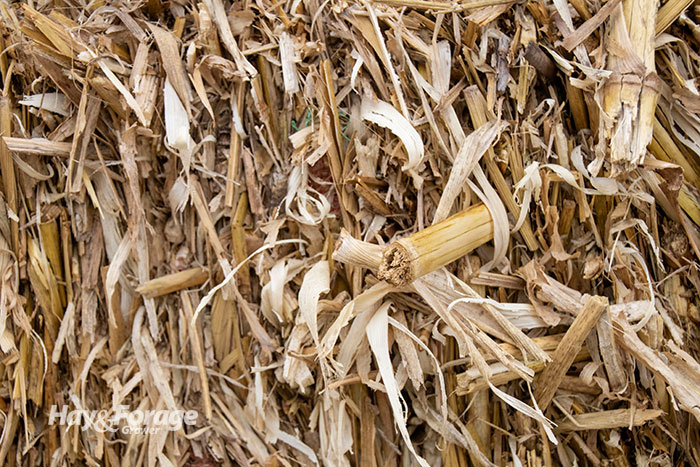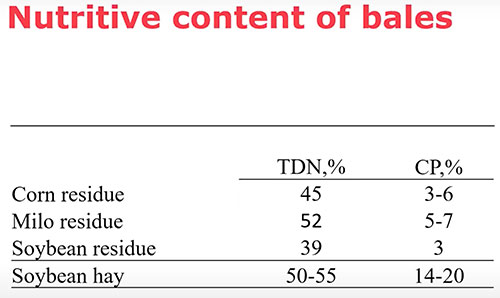
Utilizing crop residue as a winter feed source is a common practice in the Midwest. In times when forage supplies are low and hay prices are high, crop residue is especially useful to offset winter feed costs.
Darrell Peel with Oklahoma State University Extension says integrating crop and livestock production by grazing cattle on crop residue can be advantageous for cow-calf operations; however, the extent to which feed costs are mitigated might depend on the type of crop residue being grazed. Baling crop residue is another option, but it is one that involves more time, labor, and infrastructure to implement.
In a recent webinar from Oklahoma State University Extension, Mary Drewnoski with the University of Nebraska agreed that grazing crop residue is the more cost-effective and efficient approach. With that said, the extension beef systems specialist noted baled corn residue, milo residue, and soybean hay can meet cows’ nutritional needs with proper supplementation.
Drewnoski began by emphasizing the effect of forage quality on dry matter intake. The lower the quality of the crop residue, the less forage cows can consume. This ultimately translates to fewer total digestible nutrients (TDN) and less crude protein (CP) available to livestock.
A 1,300-pound cow in mid-gestation requires approximately 11.5 pounds of TDN and 1.6 pounds of CP per day, whereas a 1,300-pound cow in late gestation needs about 14.1 pounds of TDN and 2.2 pounds of CP per day. Drewnoski demonstrated how well different crop residues meet these criteria based on forage quality and resulting dry matter intakes.
Supplement corn residue
Corn residue generally has about 45% TDN and 3% to 6% CP, but these values can vary depending on conditions throughout the growing season and the proportion of stalks, husks, and leaves. Assuming the only limiting factor is forage quality, Drewnoski said a 1,300-pound cow could eat about 1.8% of its body weight in corn residue per day, which would be about 23.4 pounds of dry matter with 10.5 pounds TDN and 1.4 pounds CP.

Even though these numbers don’t meet the nutritional requirements of cows in mid- or late gestation, producers can add supplemental ingredients to ground corn residue bales to enhance feed value and palatability. Whether corn residue is fed free-choice or in a mixed ration, though, Drewnoski noted cows may be selective of high-energy forage components. This will ultimately depress dry matter intake.
“The problem is (cows) take so much time trying to sort out husks and leaves that their intakes are low,” Drewnoski asserted. “We really need to be assuming a limited amount of intake, and that means we have to calculate that into what (the residue) is providing and what else we need to provide.”
Milo has more energy
Milo residue, on the other hand, would meet the nutritional requirements of 1,300-pound cows in mid- or late gestation. Drewnoski showed this type of forage has about 52% TDN and up to 7% CP, and animals would be able to consume about 2.2% of their body weight in milo residue per day. This equates to 28.6 pounds of dry matter that contains about 14.9 pounds TDN and 2.3 pounds CP. But like corn residue, cows will likely sort out higher quality components of milo residue.
“If you were to offer (milo residue) in a free-choice hay feeder, they will be somewhat selective. They will bring up the nutrient density of the diet just a bit because they will not be eating as much of the stalk,” Drewnoski stated. “The stalk is usually lower in protein and a little bit lower in energy.”
Soybean hay is higher value
The beef systems specialist made the distinction that soybean residue is not the same as soybean hay. In fact, the former feedstuff has about 39% TDN and 3% CP, whereas soybean hay can have up to 55% TDN and 20% CP, depending on plant maturity and how much leaf material is captured at harvest.
Drewnoski cautioned that soybean hay can be high in fat content as oil accumulates in seeds over time, but fat must be limited in cattle diets. Soybean stems will also influence forage quality and animal feeding behavior.
“Like the milo and the corn residue, there is a common theme, and that is (cows) don’t like the stems. The stem is low energy, and if it is not ground, they will select it out. That increases waste, but it also allows them to select a higher quality diet,” Drewnoski stated. “Don’t expect (cows) to consume all the hay if you are feeding it in a round bale feeder and not processing it and making those stems smaller.”
Although soybean hay could meet the needs of 1,300-pound cows in mid- and late gestation, Drewnoski pointed out this forage would still not be sufficient for cows in early lactation on its own. These animals require about 17 pounds TDN and 2.9 pounds CP per day; however, mixing soybean hay with another high-energy feedstuff could be a solution to feeding lactating cows.
“If we up the amount of energy, maybe by supplementing some corn or some other grain, (cows) might be able to make better use of that protein. Then we might be able to meet their needs for both energy and crude protein,” Drewnoski said.
No matter the type of forage being fed, Drewnoski encouraged producers to submit hay samples for quality analysis. Doing so will provide more accurate data that can be used to formulate feeding plans and make the best use of crop residue bales.
